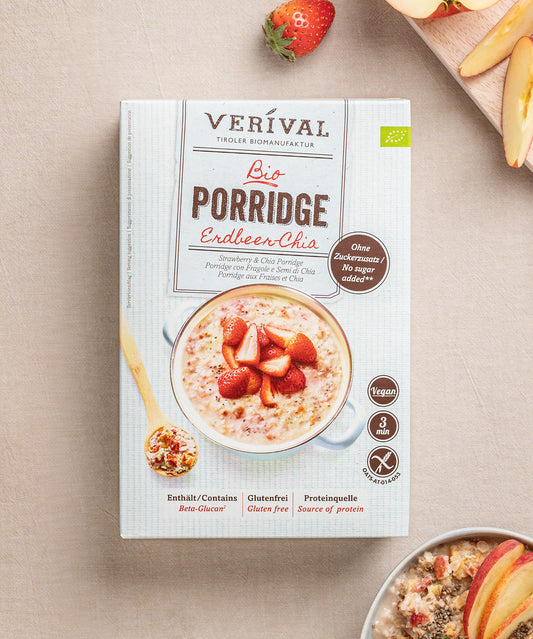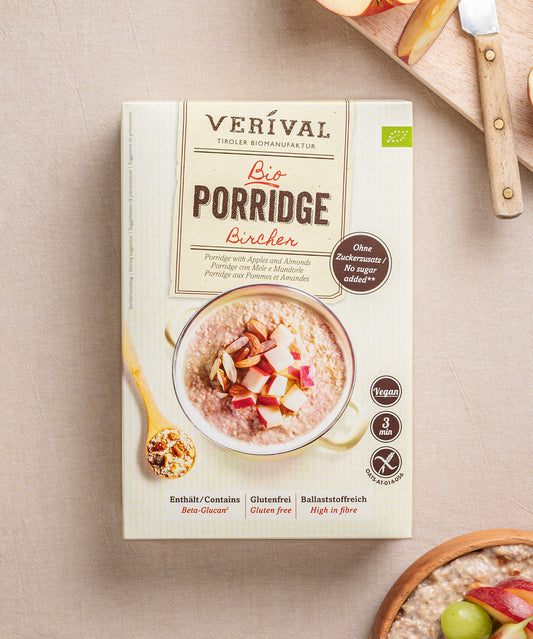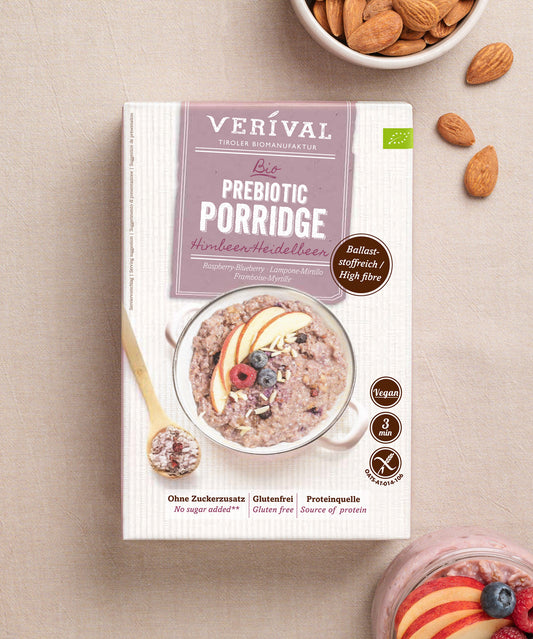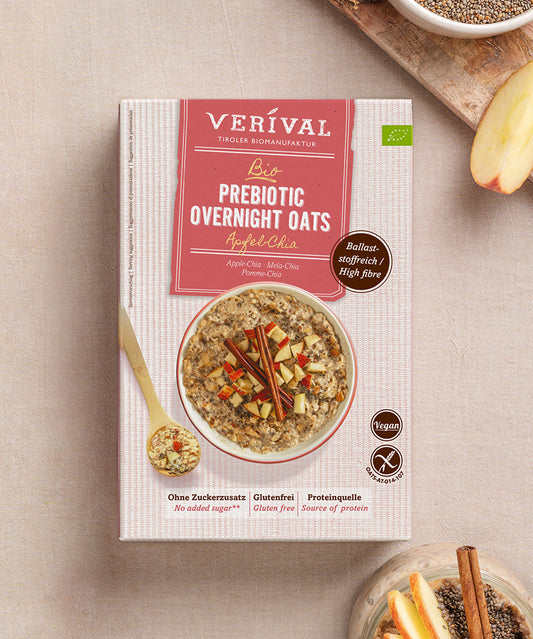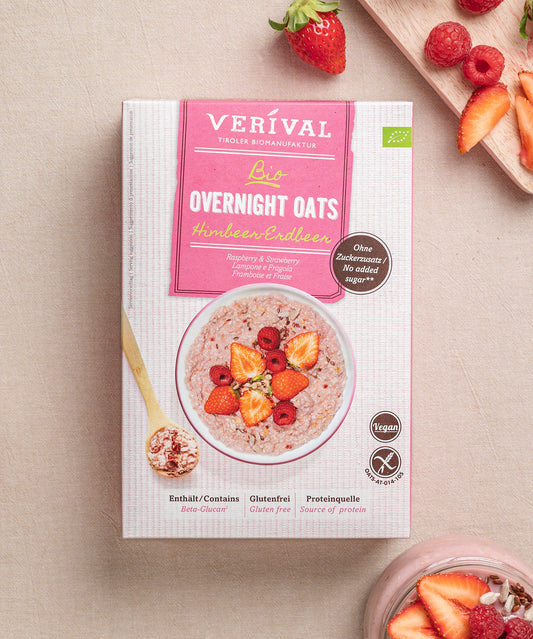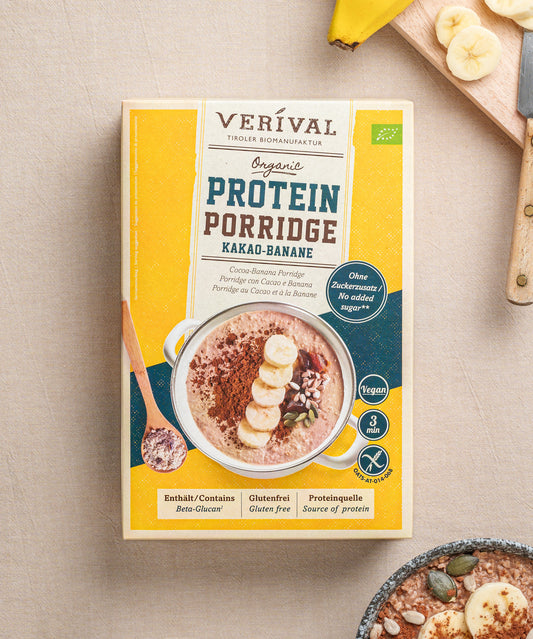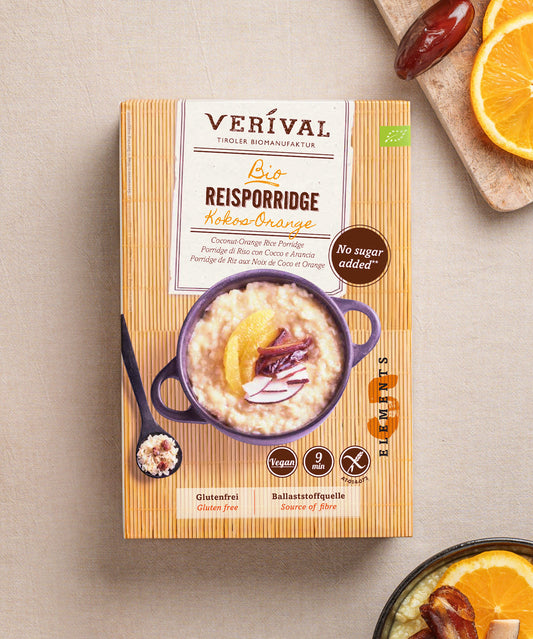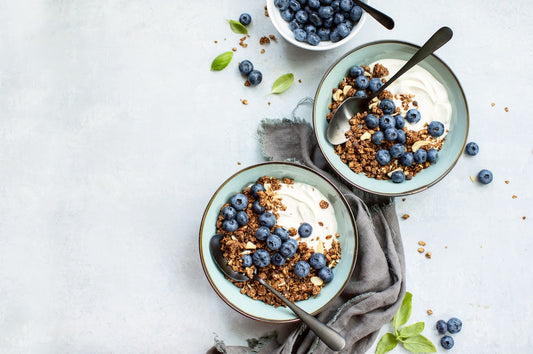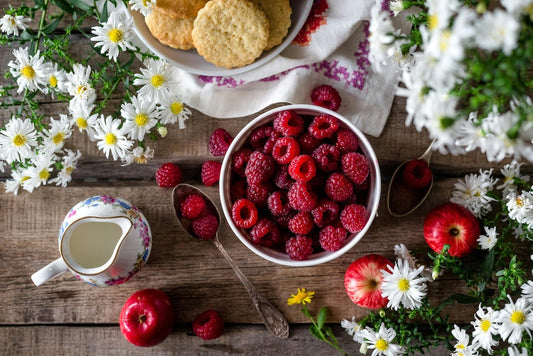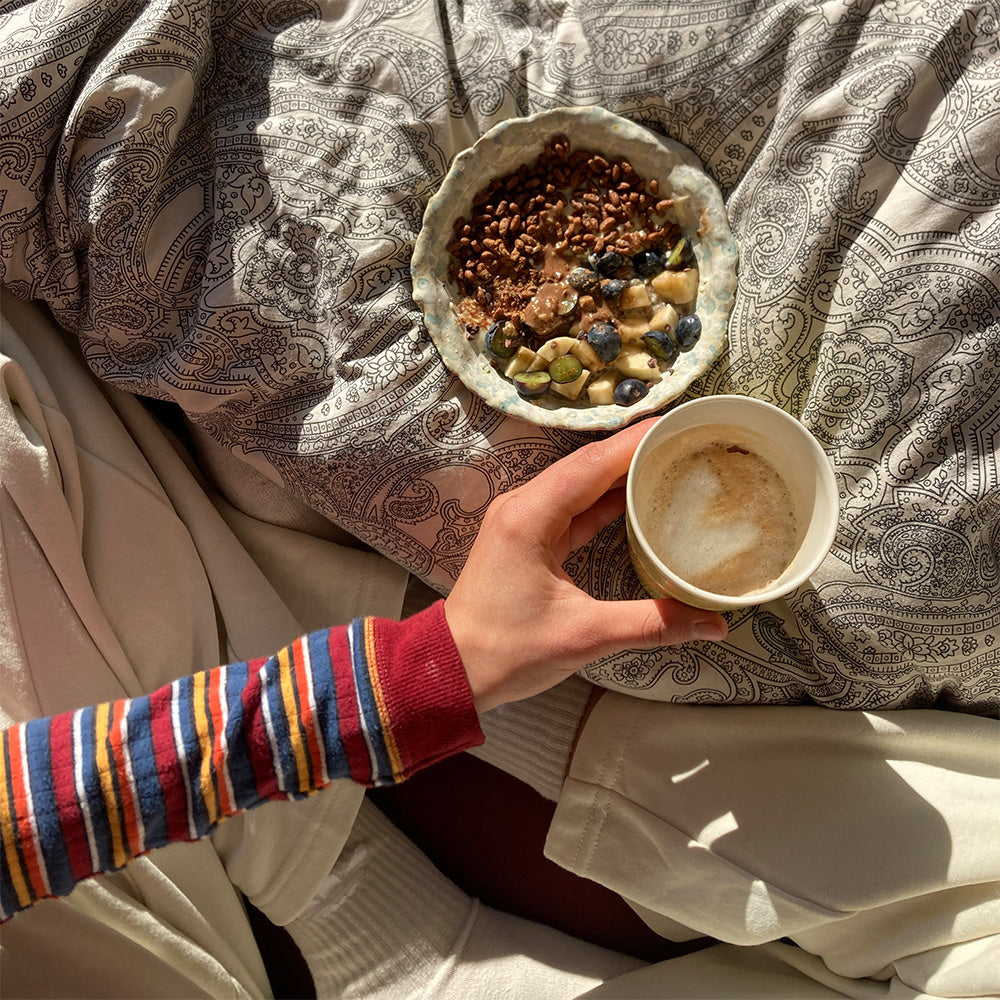Opinions on clean eating are divided. Some are completely convinced by it, while others do not see any success in this form of nutrition. We at Verival are convinced that if you do it right, you will do well with it. That is why we are going to show you the most common mistakes in clean eating in this article, so that you can avoid them.
Try Verival organic porridge now
What is clean eating?
For those who can't remember: clean eating is a form of nutrition that avoids processed products as much as possible. Instead, fresh and unprocessed foods take their place.
This means that instead of processed meat products, protein-rich legumes are served; instead of ready meals, you cook for yourself.
Plant-based foods such as vegetables and fruit form the basis of clean eating. Protein-rich legumes, fibre-rich seeds and vitamin-packed fruits and vegetables ensure natural satiation and provide you with plenty of micronutrients.
Unsweetened dairy products such as natural yoghurt, as well as organic meat and fish products, supplement the diet as needed.
How healthy is clean eating?
Clean eating can be very healthy if done right. The focus on natural and minimally processed foods ensures a high nutrient density and is therefore extremely beneficial to health.
The following list summarises the main advantages of clean eating:
- Less processed food
- Less sugar, salt and unhealthy fats
- Higher nutrient density
- Plenty of vitamins, minerals and phytochemicals
- Fibre for healthy digestion
All of this ensures that you can increase your overall well-being and at the same time prevent numerous common diseases such as cardiovascular diseases.
But clean eating doesn't only have advantages – if you don't know enough about it, you can quickly make one or two mistakes.
That's why we've put together the six most common mistakes in clean eating to help you avoid them.
These 6 mistakes you should avoid
When it comes to clean eating, mistakes are generally easy to avoid. However, they happen just as often as with other diets and forms of nutrition.
The most common mistakes are eating the wrong foods, eating too much or too little, or even over-controlling your eating behaviour. That's reason enough to take a closer look at the mistakes and offer ways to avoid them.
1. The wrong foods
Probably the most obvious mistake is to choose the wrong products. While this may sound like a mistake that shouldn't happen, it actually does happen time and again.
To help you avoid this mistake, we have put together a list of the most important clean foods below:
| Clean Foods | Reason for inclusion |
| Fruit and vegetables | High nutrient density; plenty of vitamins and minerals with a low amount of calories at the same time |
| Legumes (e.g., lentils and beans) | Healthy fiber, minerals and protein-rich |
| Nuts and seeds | High in fiber and protein as well as healthy fatty acids |
| Vegetable fats | Healthy fatty acids and fat-soluble vitamins |
| Whole grains | Complex carbohydrates and high fiber |
| Pseudocereals (quinoa, bulgur, etc.) | Complex carbohydrates as well as fiber and protein-rich |
| Unsweetened dairy products (natural yogurt, etc.) | Mineral-rich and full of proteins |
| Eggs, fish, and meat of organic quality | Protein-rich, partially containing healthy fatty acids such as omega-3 fatty acids |

Foods to avoid instead include packaged cheese, charcuterie, and sweet and salty snacks. Although the reasons for this are manifold, it is mainly due to the artificial colors and flavorings contained, which are intended to improve the taste experience. An overview can be found in the table below.
| Foods to avoid | Reason for exclusion |
| Ready meals (e.g., canned ravioli) | Lots of salt, sugar and artificial ingredients |
| Packaged Cheese | Often contains artificial colors and flavorings |
| Sausages | Plenty of salt, unhealthy fats and artificial ingredients |
| Soft drinks | Plenty of sugar or artificial sweeteners |
| Nutella, jam, etc. | High in sugar, few vitamins and minerals |
| Sweetened dairy products (fruit yogurt, etc.) | Sugary |
| Snacks (e.g., chips or salted sticks) | Lots of salt, high in calories and low in nutrient density |
| Biscuits, cakes and sweet baked goods | Lots of fat, sugar and hardly any fiber |
2. Eating too little
A potential danger of the clean eating approach is that you may be supplying your body with too few calories. Although this initially leads to a significant weight loss and may therefore seem desirable, it should not be the case.
If you want to lose weight and change your diet sustainably in the long term, you should not focus on short-term weight loss. As with so many diets, this carries the risk of the yo-yo effect.
Instead, it makes sense to consume a calorie intake that satisfies you in the long term, but still allows you to lose weight in a targeted and healthy way. This is usually the case with 200 to 400 calories below the so-called maintenance calories.
How many calories do I need to lose weight healthily? Find out more
Everything above your calorie requirement will cause you to gain weight. Anything much lower than your calorie requirement will cause you to lose weight, but not in a sustainable way.
3. Too many calories
Switching from your usual eating habits to clean eating can be a big change for some people. Avoiding sweet snacks and salty nibbles can be particularly challenging for you at the beginning.
Firstly, your taste buds and the reward centre in your brain are accustomed to receiving plenty of flavourful food. On the other hand, your stomach is stretched out due to the large portions you are used to eating, which means that you don't feel full until later.
Both of these factors can lead you to eat too large portions, which can ultimately lead to an excessive calorie intake and weight gain.
Since this is to be avoided with clean eating, you should therefore keep an eye on your energy intake. It's best to make sure you eat normal-sized portions and plenty of fibre and complex carbohydrates to naturally promote your satiety and avoid consuming too many calories.
You can also use a calorie calculator; however, this carries another risk, which we would now like to present to you.
4. Excessive control of eating behaviour
Obsessive control of eating behaviour carries risks of developing an eating disorder. For this reason, you should make sure to create a framework in which you feel comfortable. Having the calorie calculator at hand all the time may initially make you feel good, but in the long run it can do more harm than good.
To avoid getting too caught up in the diet, it makes sense to read up on it thoroughly first. This may sound paradoxical, but in the end it makes sense. Because if you get to grips with the topic of clean eating at the beginning and define the most important framework conditions for yourself, you can always fall back on this knowledge later. This can help you not to have to question everything all the time.
Ultimately, preparation can save you from constantly having questions in your head and dealing with the topic non-stop while you are changing your diet. Once you are familiar with the concept of clean eating, it is actually quite simple.
5. Restricting yourself too much
Those who restrict themselves too much run the risk of only being able to maintain the change in diet for a short period of time. However, since clean eating is about a long-term and sustainable diet, you should avoid this mistake.
That's why it's better to keep one or two products in your daily diet instead of forcing yourself to leave them out completely. This is because the first phase of the change in diet is particularly challenging.
If your body is used to getting chocolate regularly, going without it completely from the outset may be too much of a restriction. This can cause you to revert to your old eating habits after a short time.
In such cases, it is probably better to reduce your consumption gradually. Another option is to replace the ‘forbidden’ product with a permitted one.
For milk chocolate, this could be sweet dates or other types of fruit. However, the principle of substitution should not be overused.
Fresh fruit provides natural sweetness – for example, as a topping for porridge or natural yoghurt.
6. Blindly substituting ‘forbidden’ foods
If you simply replace chocolate with dates, for example, you may end up eating unhealthily again. Dates are not bad for you in principle, but in too large quantities, the effect is different.
Therefore, when replacing foods, pay attention to the amount you consume. After all, the dose makes the poison. Dates are much healthier than a bar of milk chocolate, but this can no longer be said if you eat too many.
Because dates also contain sugar – and you should only eat them in moderation. Otherwise, you risk high blood sugar fluctuations, food cravings and ultimately unwanted weight gain.
So when replacing, the same rule applies: reduce first, then replace. This way you avoid excessive sugar consumption and prevent severe blood sugar fluctuations.
How to succeed at clean eating with VERIVAL
Clean eating is easiest when you enjoy it and don't feel like you're missing out on anything. You can achieve this by eating a varied diet. It's best to start with breakfast.
One portion of Verival porridge is roughly in line with the principles of clean eating. At the same time, there are countless variations of porridge, which helps to keep your daily diet varied.
For example, you can top your porridge with nuts one day, with healthy linseed the next and with fresh berries on the third – making clean eating easy!






